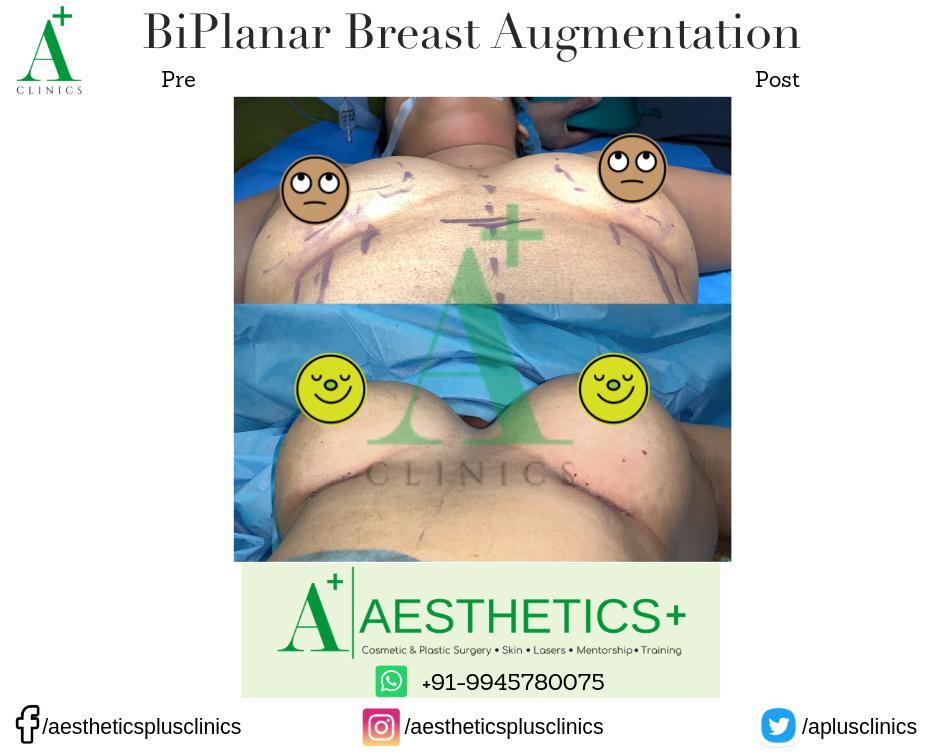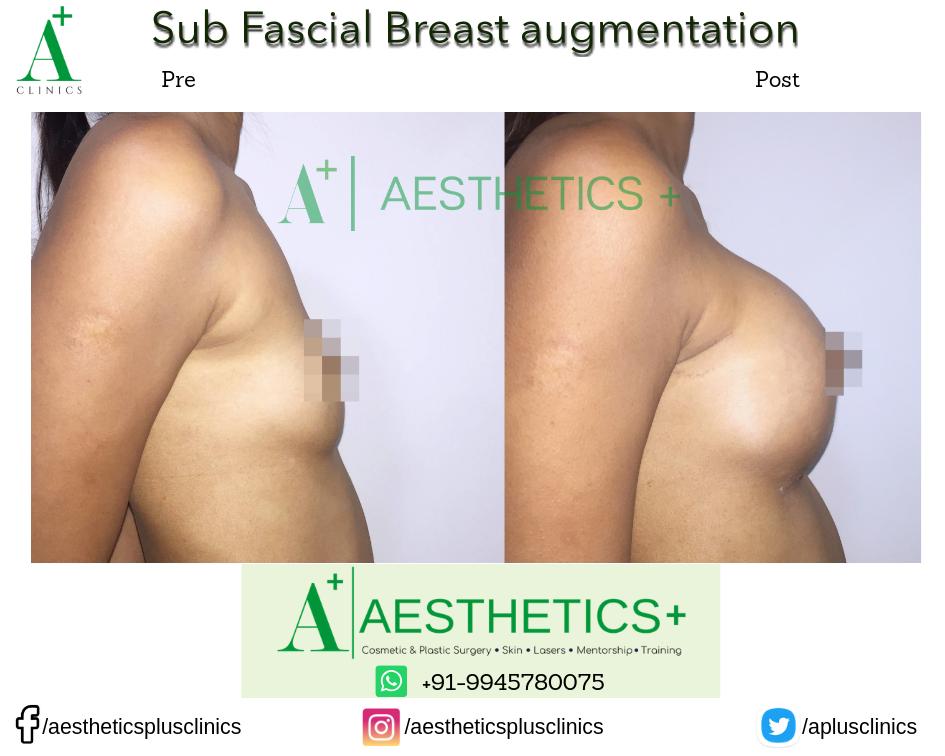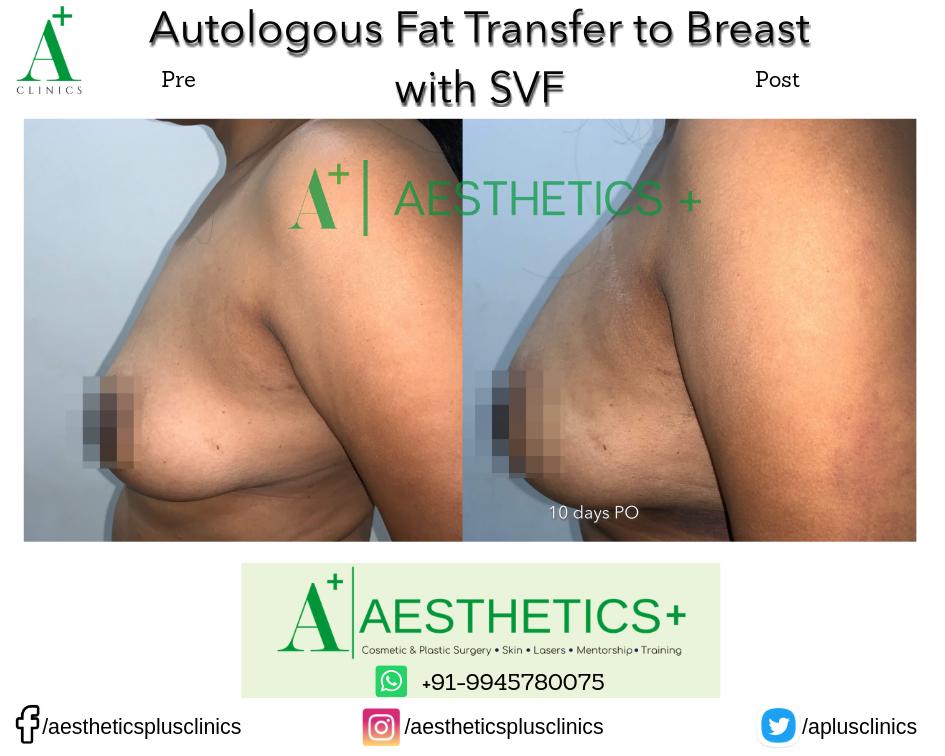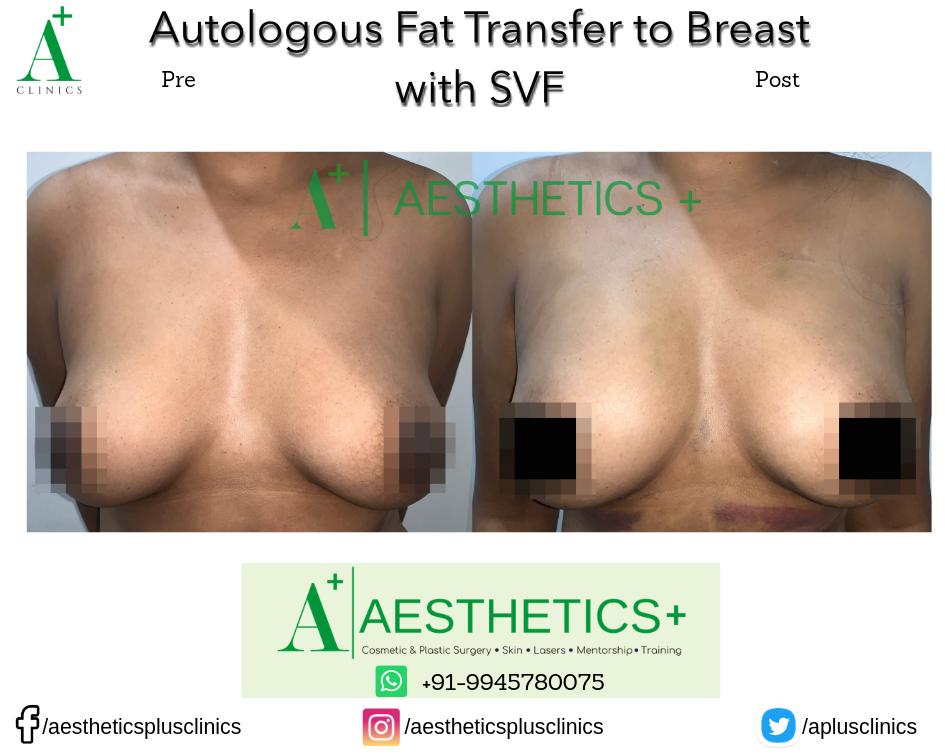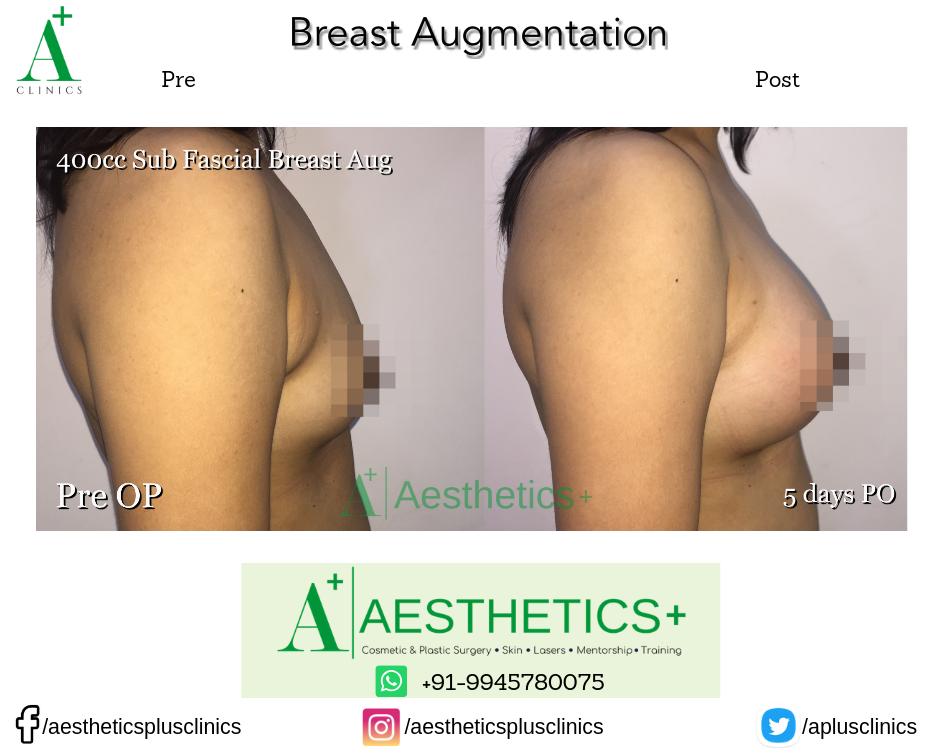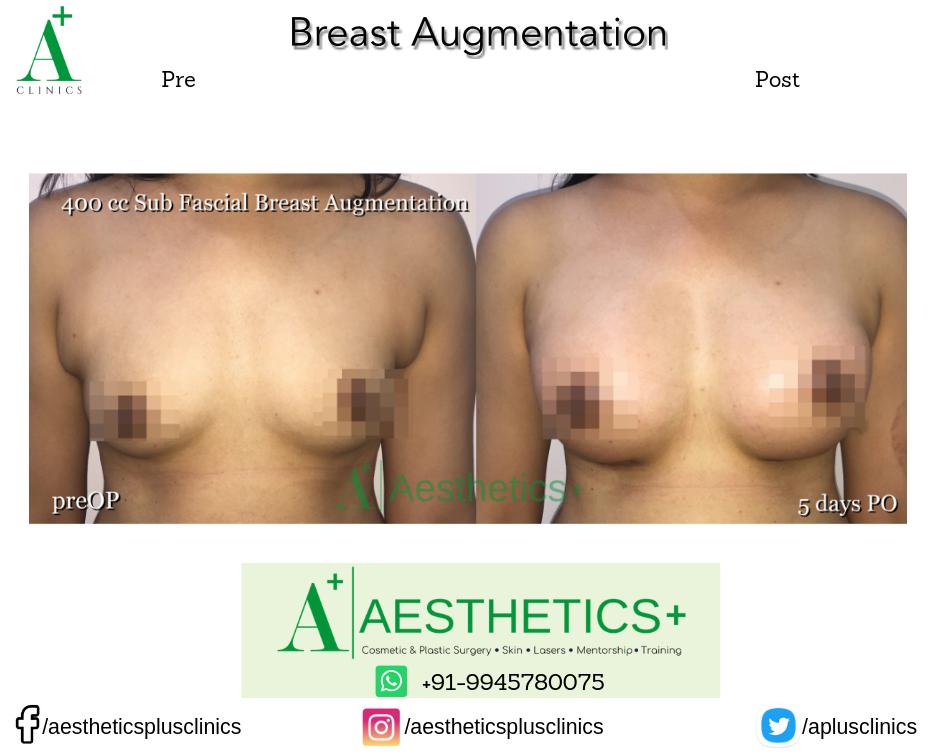Breast Augmentation Surgery in Bangalore
- 5/5
- 175 reviews
- Services
- Breast
- Breast Augmentation
Get your desired breast size with a breast augmentation-implant surgery in Bangalore at affordable cost
- Are you feeling underconfident due to small breasts?
- Do you struggle to find clothes that fit you correctly?
- Is your sexual relationship getting affected due to small breasts?
- Do you want to enter the glamour world of modeling or acting and desire a stunning figure?
Before / After
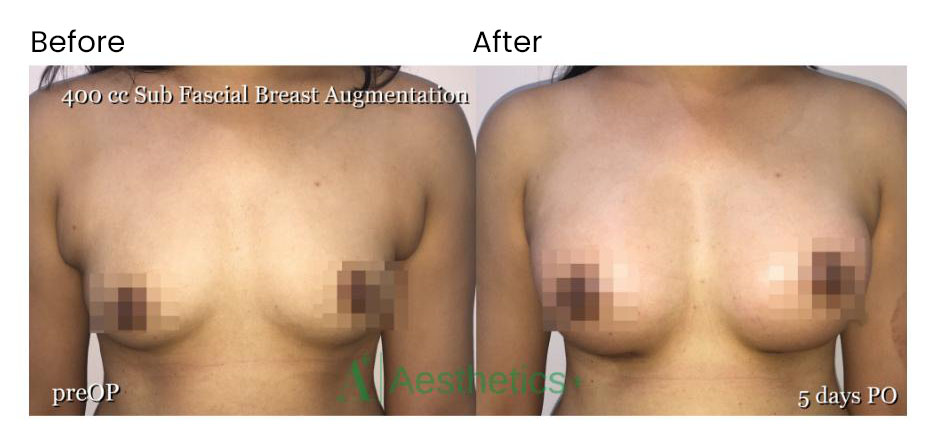
What is a Breast Augmentation Surgery?
Breast Augmentation Surgery in Bangalore, or breast enlargement surgery, is done to improve the breast size, contour, and volume. Breasts have always been considered a sign of femininity. But not all women are blessed with naturally well-proportionate and aesthetically pleasing breasts.
The lack of breast volume or small breasts is a primary concern for girls and women. An imbalance between the upper and lower body in some women also makes the breasts appear smaller than they are.
Also called augmentation mammoplasty, this procedure can be done by placing implants beneath the breast tissue or breast muscles or through autologous (your own) fat transfer. Breast augmentation in Bangalore is a popular procedure among women who want to have a proportionate and shapely figure.
Our board-certified breast surgeons at Aesthetics Plus, Bangalore, are known for natural-looking, safe, and long-lasting breast enlargement results.
Who is an Ideal Candidate for Breast Enlargement Surgery?
- Note absence of breasts since birth.
- Have small breasts that are not proportionate to their body
- Lost breast volume and size due to childbirth, aging, or weight loss
- Observe the difference in size between the right and left breast
- Have deformities in the breast like tuberous breast.
- Have fought breast cancer and undergone breast surgery or chemotherapy and want to regain their femininity through breast reconstruction
Schedule an Appointment
Related Videos
Have Any Question?
Reach out to our knowledgeable staff to know more details about the treatment.
- +91 9945780075
- +91 9606170075
- hello@aestheticsplus.in
Happy Patients
Total Surgeries
International Patients
Countries Served
How To Prepare for Breast Enlargement Procedure?
In an initial consultation, the breast surgeon at Aesthetics Plus, Bangalore, will evaluate your current breast size and shape, the overall body structure, and health.
We encourage a woman coming in for breast enhancement surgery in Bangalore to take an active role in deciding the size, the shape of the breasts, and the amount of cleavage she wants.
The possibilities vary, and the breast surgeons customize the procedure to cater to an individual’s needs and liking. We at Aesthetic Plus will involve you in every plan to understand your desires and expectations.
The surgeon will take necessary measurements and plan the plane of implant and the implant size and type. You will be active in this planning and should understand the procedure’s limitations.
Once you finalize the date of your breast surgery, follow the process to book the procedure. Read the following instructions to prepare for breast augmentation surgery at Aesthetics Plus.
Breast Augmentation Surgery Process
During augmentation mammaplasty, the patient receives intravenous medications or general anesthesia to keep them comfortable during the process. The surgeon and the anesthetist decide the choice of anesthesia.
According to the previously decided surgical plan, the surgeon makes the necessary incisions to create a pocket to place the implants. Inframammary (crease) incision, trans-axillary incision, periareolar incision, transumbilical or TUBA incisions are the different types used. The breast surgeons at Aesthetics Plus try to make the incisions so that there is minimum scarring visible. The incision type depends on the implant used, the amount of enlargement needed, and the patient’s and the doctor’s preference.
Implants are placed in the pockets to give the required elevation to the breasts. Usually, we place the implants in the submuscular/subpectoral, pre-pectoral, or subfascial planes. The type of implant, augmentation desired, surgeon’s and patient’s preference determines the implant placement.
Finally, the incisions are closed using sutures, and superficial incisions are covered with surgical tape.
Recovery from Breast Enlargement Surgery
After the procedure, the patient is transferred to our recovery room and monitored as the anesthesia wears off. The patient also receives painkillers to help reduce the pain. Surgical dressings and wrap are applied. We discharge the patient after a few hours once we are satisfied with the patient’s condition. Driving is not allowed on the same day.
While the surgical dressings come off after four days to a week, the patient can shower. The complete recovery from the surgery will take around three to six months. The patient should follow our surgeons’ instructions about the restrictions, wound care, exercise, and follow-ups. If the patient develops any redness, fever, or oozing from the surgical sites, they should contact the doctors immediately.
The surgical scars will slowly fade and lighten as the healing happens.
Risks Associated with a Breast Size Increase Surgery
Though every attempt is made to give the best possible result, because the body healing varies, some problems may occur as with any other procedure. The scar in the inframammary or periareolar approach may be visible.
Sometimes, the breast volume may vary on the left and right sides, depending on the amount of breast tissue already present.
When we place the implant behind the muscle, it stays high sometimes, and the normal breast tissue, if less or lax, tends to slide down, giving a double bubble appearance on standing. More commonly, we can see the breast tissue in the axillary approach. Over time, the implants “settle down” to a lower level than initially as the swelling decreases, and this problem settles. Rarely the breasts may need some minor adjustments.
In rare instances, bleeding is a problem, but adequate care is taken during the procedure to prevent such complications. If there is a small collection of blood, we can leave it alone as it usually gets absorbed; but, if the quantity is more, it may require an evacuation of the collected blood.
If there is excessive sagging of the breasts, breast tightening or reshaping “mastopexy” is combined with breast enlargement.
Autologous Fat Transfer to the Breast or Scarless Breast Enlargement
Though structural fat grafting has been used to augment other areas of the body, like the buttocks and the face, doctors did not advocate it for the breast. This hesitation was due to fear of breast calcifications caused by some of the dead fat interfering with mammograms and thereby hampering cancer detection protocols.
But studies have shown that calcification patterns from dead fat cells and calcification patterns from cancer are different and can be distinguished. Hence, there is a renewed interest in fat grafting to the breast to increase breast volume.
In this procedure, the fat is harvested from other areas of the body, purified, concentrated, and injected into different planes of the breast to augment the size. So, it is a combination of liposuction of one area and lipofilling of the breast.
One disadvantage of this procedure is that the patient must have fat in other areas to harvest. Secondly, the take of the grafted fat, i.e., the amount of fat that ultimately stays on in the breast, is a little unpredictable. A second procedure is often required after 6-8 months to refill the breast to the desired volume.
But as the techniques are getting better and with a better understanding of the survival processes of the grafted fat, we now routinely use PRP (platelet-rich plasma) along with our fat grafts to enhance the survival rate.
What is the Breast Augmentation/Implant Surgery Cost in Bangalore?
If we discuss breast enlargement cost in Bangalore, we would say it depends on multiple factors. The type of implants, the desired augmentation, surgeon’s expertise, surgical technique, clinical facilities, anesthesia, medications, etc., should be considered.
Though it is difficult to give an exact breast augmentation surgery cost in Bangalore, it can start from 125000. Implant cost is additional depending on which you choose. Once you consult our breast surgeons, we can provide the actual price.
+91 9945780075 or +91 960617007. Please email us at hello@aestheticsplus.in.
Testimonials
What Patients Say About Us
Wonderful experience with Aesthetic plus. Dr. Surindhar is incredible, not only has explained me entire procedure but also ensured I had a smooth prep, surgery, and follow-up. It’s rare to find a doctor that combines such personal touches and care for a patient as a person with outstanding quality of medical care. I am so glad I chose Aesthetic Plus and would highly recommend.
It was a great experience to get treated from Aesthetic Plus. The service, doctors, helpers and environment was quite friendly and comfortable. This treatment has changed my life into something better. I would recommend you all to give it a try and find yourself how they change your life too.... Thanks to Team Aesthetic Plus & DR. Surindher Sir
Visited Dr Surindher for a procedure which I was contemplating for a very long time. He made me extremely comfortable and explained everything in detail which made me gain confidence to go ahead with the procedure. The procedure went well with no pain at all.Post the procedure there was minor discomfort for 2-3 days and Dr Surindher was always available on call to help address any concern and to follow up with the progress.The post operative follow up was brilliant. Highly recommended Dr Surindher! Cheers and thank you !
I've known Dr. Surindhar for many years now, when he performed a surgery for removal of my axillary lymph nodes which was such an investment to my health and an addition to it's aesthetics was a bonus. I like his approachability n the precision of work, be it non or invasive jobs- big or small. I would highly recommend him for any of your cosmetic/ aesthetics related work.
Got a chemical peel from Dr.Surindher for my acne scars. My skin felt very smooth and brighter after the procedure. Had a really comfortable experience at the clinic and doctor was very patient in answering all my frequent follow up questions.
Nice place. Neat and clean. Courteous staff. Knowledgable doctor good hands didnt force me and my husband regarding procedures and gave us all the facts. I got a mummy makeover( tummy tuck + breast lift) and hubby got a hair transplant with the Aesthetics Plus team. Very happy with the result. Waiting for hubby's final result. Thank you DrSurindher and team. Keep it up
Hair transplant and gynaecomastia correction done. Had surgery before elsewhere but depression and scarring was there, which was corrected very well and no drains and actually no pain at all. then got FUE also done last year. Very happy. will recommend to all. thank you.
FAQ's
A breast implant is a soft silicone shell filled with silicone gel or saline that increases the breast volume and size.
Types of implants
The silicone gel implants are made of a silicone shell and filled with silicone gel. They are relatively permanent as they do not deflate. But they require a larger incision size to insert. They have a natural feel, and the new highly cohesive gel implants do not leak even if punctured or cut.
The saline implants are silicone bags into which saline is injected to fill it up. The advantage of these implants is that we need smaller incisions to place the implant, and the sizes can be increased or decreased in case of volumetric discrepancies between the right and the left breasts. But, the disadvantage is that the saline may leak over many years and need replacement. But these are no longer available freely in India but can be ordered if desired.
We also find implants of different sizes, shapes, and textures. The breast surgeon discusses these options with the patient during the consultation and then decides. The choice of the implant is usually left to the patient and forms a significant component of the cost of breast augmentation surgery.
We can place the incisions in one of three places for implant introduction. Incision choice is dependent on the implant type and size and the comfort level and experience of the physician with that specific incision.
Inframammary (crease) incision:
The incision is placed just in the skin crease where the breast meets the chest wall, usually along the breast meridian. It allows easy placement of the implants. This approach is helpful if bigger-sized implants need insertion. But the problem is that there is a visible scar on the lower part of the breast, which generally settles with time but doesn't vanish. The scar usually merges with the skin crease over time. This is the most commonly used approach to breast augmentation the world over.
Transaxillary incision:
The incision is placed in the armpit. The benefit of this incision is that it is in a natural crease. There is no chance for increased scar stretching since there is no weight or tension against the incision after implant placement. But since the incision is away from the site of actual implant placement, it restricts the size of the implant that can be inserted. Secondly, the dissection is more extensive; hence the pain is a little more. Thirdly, the scar may be visible when wearing sleeveless dresses and lifting the arms.
In some cases, the nipple sensation recovery also takes longer. The most crucial drawback of this incision is that we need a new incision to change or correct the implant as we cannot do it through the same incision. Also, we need to convert the cut to the one below the breast.
Periareolar Incision:
The periareolar incision is done at the areola and skin border and remains hidden. However, the skin may stretch during healing, and the scar may widen slightly. This approach limits the implant size we can insert based on the areola size. There is a chance for decreased nipple sensation for a few months. Some ducts may get damaged during this approach but usually don't cause any problem during breastfeeding.
Trans-umbilical or TUBA Incision:
Here the incision is placed inside the umbilicus or belly button and is hidden. We can insert only saline implants by this method, also called the "scarless breast augmentation."
Planes of Implant Placement:
Subfascial:
This is a newer approach popularized by Dr. Ruth Graf from Brazil. Here the implant is placed under the covering or (fascia) over the pectoralis major muscle. This approach gives all the advantages of a sub-muscular placement without the pain of a muscle dissection. Sometimes though, this layer is not well-formed, so we do a sub-muscular placement. This placement has been our preferred area of placement for the last 4-5 years.
Submuscular or Subpectoral:
Placement of the breast implant under (behind) the pectoralis muscle is preferred in women with less breast tissue since the results are more aesthetic. The pectoralis muscle covers about two-thirds of the upper part of the implant. With this placement, there are fewer chances of rippling, though it may still occur in areas not covered by the muscle, specifically the outer sides and bottom of the breasts. The advantage is that the normal breast tissue is far away from the implant and hence does not interfere with self-breast examination and mammography at a later date. Muscle contractions may flatten the implant out a little. Placement behind the muscle does not preclude the exercise of those muscles, and one can get back to regular activities in a few weeks. Also, the incidence of capsular contracture is decreased with this placement. This is the most common area of placement of implants.
Sub-glandular or Pre-pectoral:
Placement of the implant over the pectoralis muscle provides a more distinct cleavage line than placement under (behind) the muscle. It also allows for larger implant placement. The recovery time is shorter, pain is less, and the implant shifts less compared to placement behind the muscle. Patients who are bodybuilders, highly muscular women, or sportswomen go with this placement. But capsular contractures are more, and if breast tissue is thin, then the ripples of the implant and edge of the implant may be seen on the skin.
Breast Augmentation with stem cells is being tried in combination with autologous fat transfers. Initial results look promising, but we still await long-term findings. Fat is harvested via liposuction; some of it is sent for mesenchymal stem cell isolation and culture. After three weeks of culture, the stem cells are injected into the breast tissue.
The patient experiences some pain and discomfort for two to three days after the operation, especially along the incisions that are manageable with simple pain medication. Some slight discomfort and tenderness may continue for up to two to three weeks, ultimately settling with healing.
Breast enhancement with implants is a surgical procedure with scars along the incision lines. However, the scar's location depends on your surgeon's placement of the incisions. In the inframammary approach, the incision is made beneath your breasts along the natural crease and is easily hidden. In the periareolar incision, the scar gets camouflaged along the areolas. The transaxillary incision has no scar on the breast and is placed in the underarm region. With healing, the scars will settle and start to fade. It may take up to even a year or more for scars to completely heal.
With breast enlargement with fat grafting, there are no scars.
If you decide that you don't want the implants at a later date, you can have them removed. Changing it for a smaller implant is also possible. However, the skin might have stretched and may not give the best results. Consult our breast surgeons, who will rightly advise and also suggest if an additional procedure like a breast lift is necessary.
You should wait three months after delivery and stopping breastfeeding to consider a breast augmentation. As changes continue in the breast after delivery and during breastfeeding, you should wait for them to settle down.
No, implants don’t hamper breastfeeding if the surgery is planned and executed properly. It would be best if you discussed this with our surgeons. Our breast surgeons will carefully suggest the size and shape of the implant according to your body structure and the surgical approach that will not damage the milk ducts.
If an appropriate implant is used, the sensation of the nipple remains intact. Rarely even if the nipple sensation diminishes, it will return in around six months, and it is uncommon for nipple sensation to be lost entirely.
Aesthetics Plus has some of the best breast surgeons in Bangalore who are highly skilled in all breast procedures. They are here to help you through every step, from selecting the right implant to safely performing surgery. At Aesthetics Plus, your safety and desires are given priority, and we strive to provide you with natural-looking results that enhance your womanhood.
Start Your Transformation Today
Author: Dr Surindher D.S.A, MBBS, MS (General Surgery), MCh (Plastic Surgery) Dr Surindher, a board-certified cosmetic, plastic, and reconstructive surgeon, is the author of this write-up and fully verifies the authenticity of the information mentioned in this content. He is a specialist in facial surgery, body contouring, breast surgery, hair transplant, cosmetic gynecology, and reconstructive plastic surgery.
Schedule an Appointment
Related Videos
Have Any Question?
Reach out to our knowledgeable staff to know more details about the treatment.
- +91 9945780075
- +91 9606170075
- hello@aestheticsplus.in
